Global Business Strategy
VerifiedAdded on 2023/01/11
|13
|4126
|44
AI Summary
This assignment discusses the global business strategy used by TESCO, an international chain of supermarkets located in the UK. It explores the SWOT and PESTLE analyses for assessing the micro and macro environment. It also examines the Ansoff Matrix and Porter Generic Strategy for achieving competitive advantages. The assignment provides insights into the importance of strategy formulation and the challenges of internationalization.
Contribute Materials
Your contribution can guide someone’s learning journey. Share your
documents today.
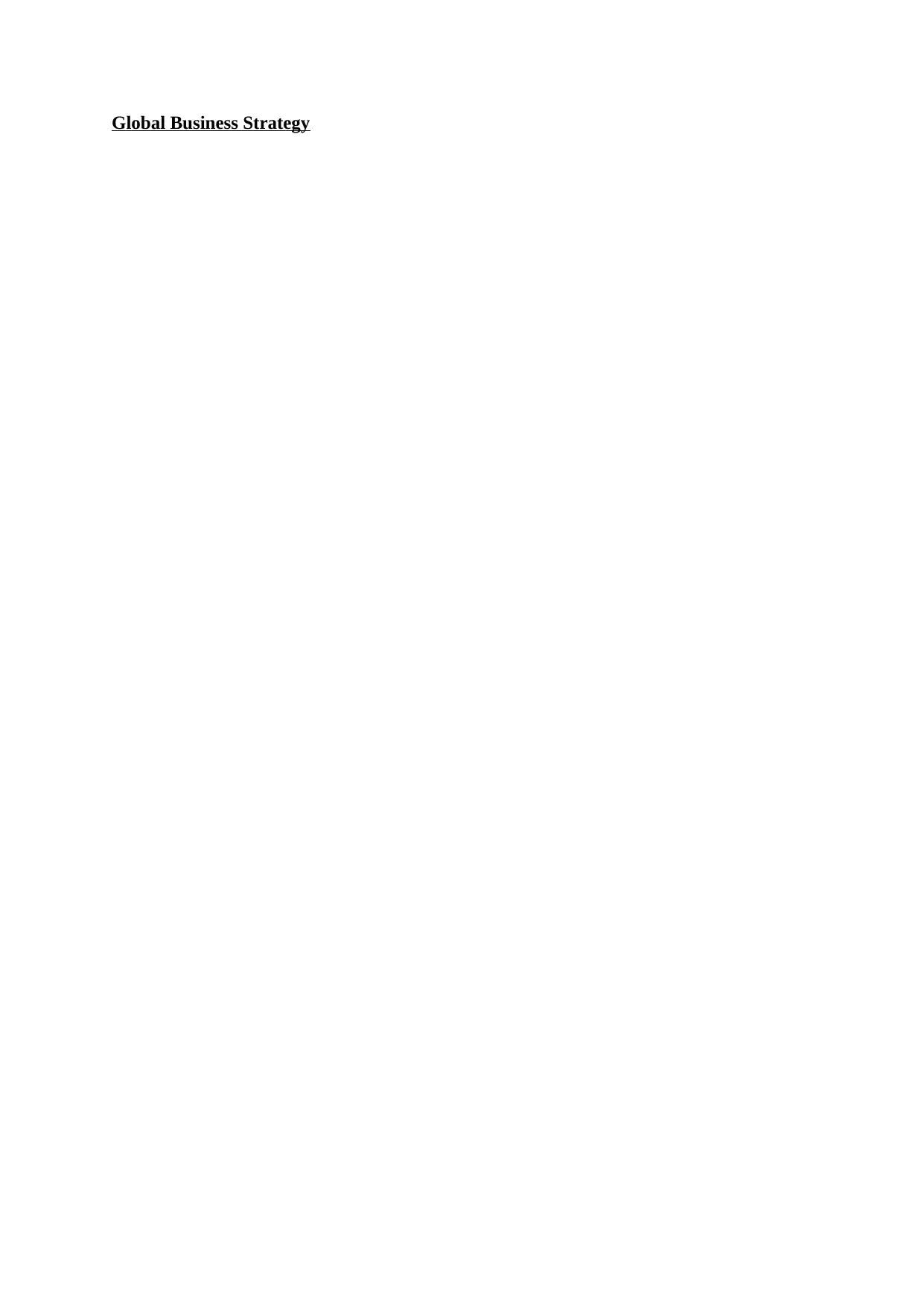
Global Business Strategy
Secure Best Marks with AI Grader
Need help grading? Try our AI Grader for instant feedback on your assignments.
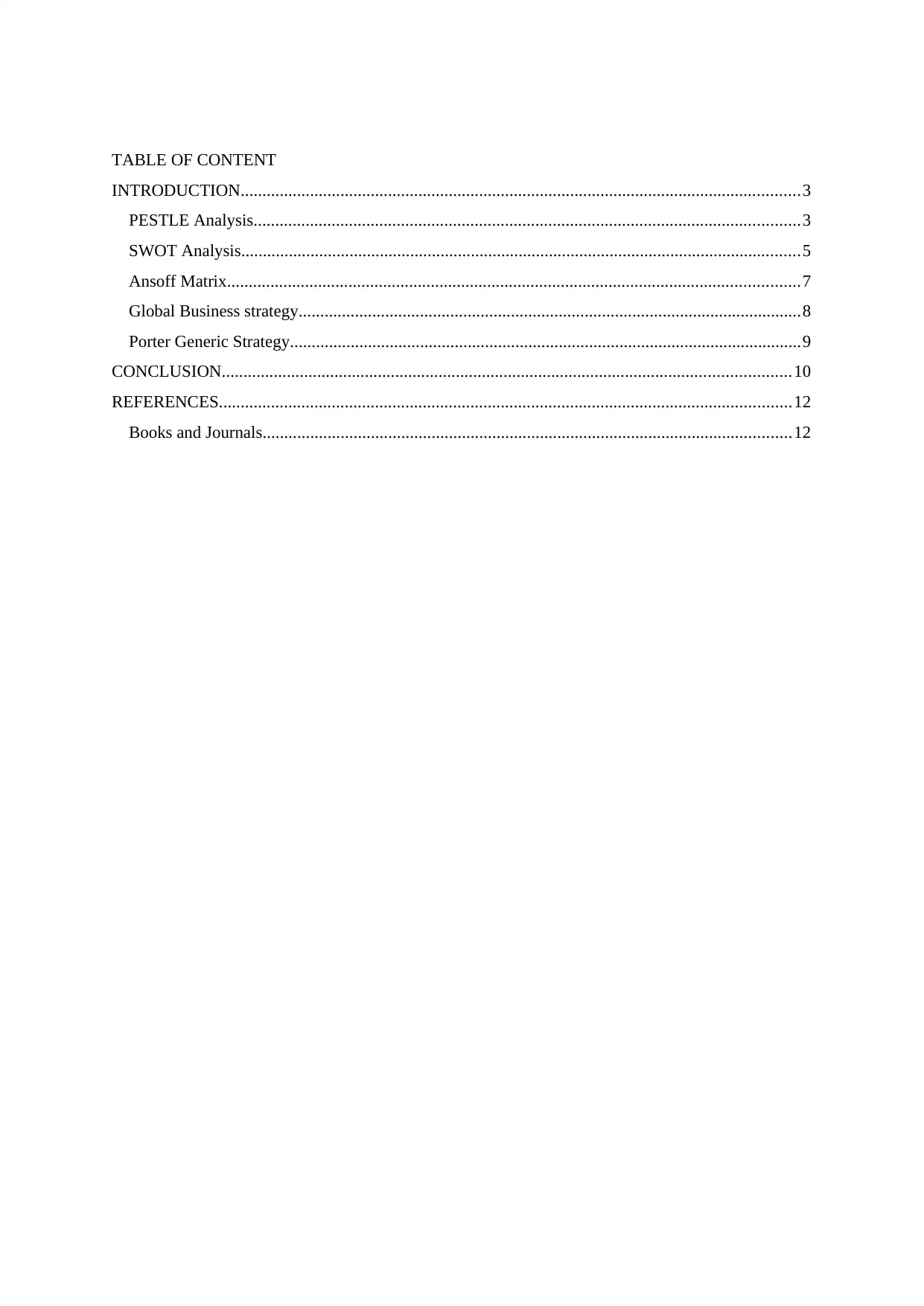
TABLE OF CONTENT
INTRODUCTION.................................................................................................................................3
PESTLE Analysis..............................................................................................................................3
SWOT Analysis.................................................................................................................................5
Ansoff Matrix....................................................................................................................................7
Global Business strategy....................................................................................................................8
Porter Generic Strategy......................................................................................................................9
CONCLUSION...................................................................................................................................10
REFERENCES....................................................................................................................................12
Books and Journals..........................................................................................................................12
INTRODUCTION.................................................................................................................................3
PESTLE Analysis..............................................................................................................................3
SWOT Analysis.................................................................................................................................5
Ansoff Matrix....................................................................................................................................7
Global Business strategy....................................................................................................................8
Porter Generic Strategy......................................................................................................................9
CONCLUSION...................................................................................................................................10
REFERENCES....................................................................................................................................12
Books and Journals..........................................................................................................................12
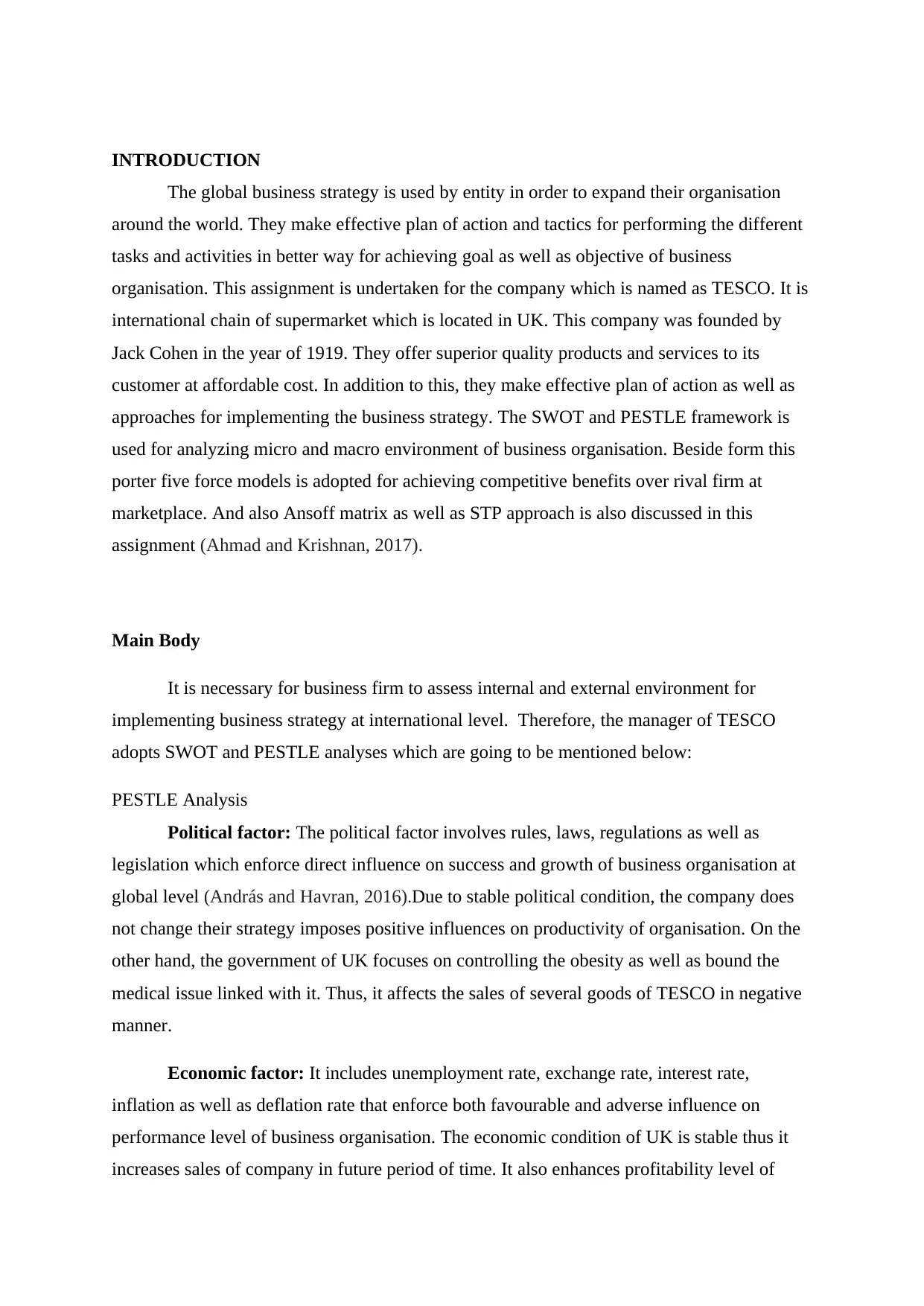
INTRODUCTION
The global business strategy is used by entity in order to expand their organisation
around the world. They make effective plan of action and tactics for performing the different
tasks and activities in better way for achieving goal as well as objective of business
organisation. This assignment is undertaken for the company which is named as TESCO. It is
international chain of supermarket which is located in UK. This company was founded by
Jack Cohen in the year of 1919. They offer superior quality products and services to its
customer at affordable cost. In addition to this, they make effective plan of action as well as
approaches for implementing the business strategy. The SWOT and PESTLE framework is
used for analyzing micro and macro environment of business organisation. Beside form this
porter five force models is adopted for achieving competitive benefits over rival firm at
marketplace. And also Ansoff matrix as well as STP approach is also discussed in this
assignment (Ahmad and Krishnan, 2017).
Main Body
It is necessary for business firm to assess internal and external environment for
implementing business strategy at international level. Therefore, the manager of TESCO
adopts SWOT and PESTLE analyses which are going to be mentioned below:
PESTLE Analysis
Political factor: The political factor involves rules, laws, regulations as well as
legislation which enforce direct influence on success and growth of business organisation at
global level (András and Havran, 2016).Due to stable political condition, the company does
not change their strategy imposes positive influences on productivity of organisation. On the
other hand, the government of UK focuses on controlling the obesity as well as bound the
medical issue linked with it. Thus, it affects the sales of several goods of TESCO in negative
manner.
Economic factor: It includes unemployment rate, exchange rate, interest rate,
inflation as well as deflation rate that enforce both favourable and adverse influence on
performance level of business organisation. The economic condition of UK is stable thus it
increases sales of company in future period of time. It also enhances profitability level of
The global business strategy is used by entity in order to expand their organisation
around the world. They make effective plan of action and tactics for performing the different
tasks and activities in better way for achieving goal as well as objective of business
organisation. This assignment is undertaken for the company which is named as TESCO. It is
international chain of supermarket which is located in UK. This company was founded by
Jack Cohen in the year of 1919. They offer superior quality products and services to its
customer at affordable cost. In addition to this, they make effective plan of action as well as
approaches for implementing the business strategy. The SWOT and PESTLE framework is
used for analyzing micro and macro environment of business organisation. Beside form this
porter five force models is adopted for achieving competitive benefits over rival firm at
marketplace. And also Ansoff matrix as well as STP approach is also discussed in this
assignment (Ahmad and Krishnan, 2017).
Main Body
It is necessary for business firm to assess internal and external environment for
implementing business strategy at international level. Therefore, the manager of TESCO
adopts SWOT and PESTLE analyses which are going to be mentioned below:
PESTLE Analysis
Political factor: The political factor involves rules, laws, regulations as well as
legislation which enforce direct influence on success and growth of business organisation at
global level (András and Havran, 2016).Due to stable political condition, the company does
not change their strategy imposes positive influences on productivity of organisation. On the
other hand, the government of UK focuses on controlling the obesity as well as bound the
medical issue linked with it. Thus, it affects the sales of several goods of TESCO in negative
manner.
Economic factor: It includes unemployment rate, exchange rate, interest rate,
inflation as well as deflation rate that enforce both favourable and adverse influence on
performance level of business organisation. The economic condition of UK is stable thus it
increases sales of company in future period of time. It also enhances profitability level of
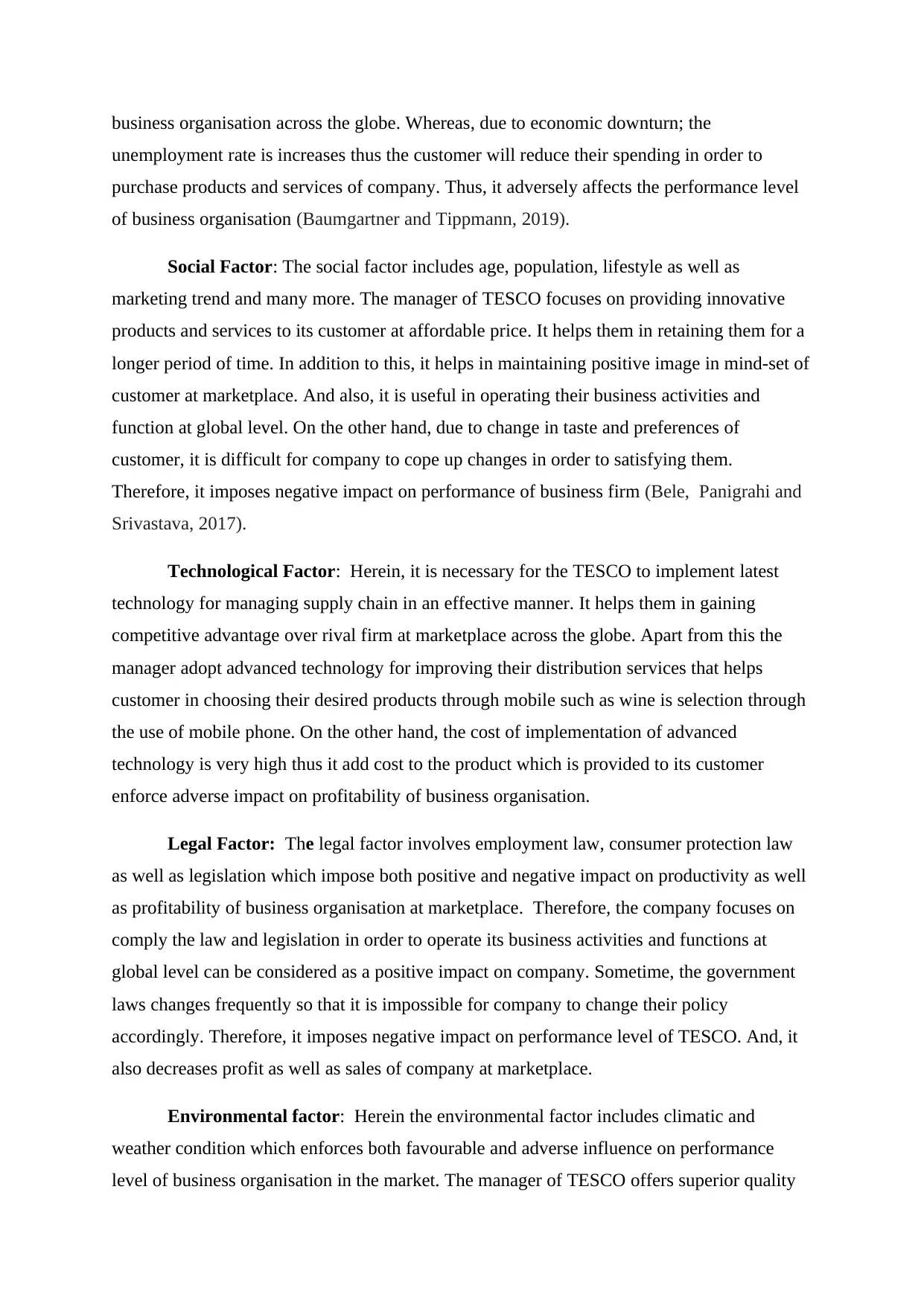
business organisation across the globe. Whereas, due to economic downturn; the
unemployment rate is increases thus the customer will reduce their spending in order to
purchase products and services of company. Thus, it adversely affects the performance level
of business organisation (Baumgartner and Tippmann, 2019).
Social Factor: The social factor includes age, population, lifestyle as well as
marketing trend and many more. The manager of TESCO focuses on providing innovative
products and services to its customer at affordable price. It helps them in retaining them for a
longer period of time. In addition to this, it helps in maintaining positive image in mind-set of
customer at marketplace. And also, it is useful in operating their business activities and
function at global level. On the other hand, due to change in taste and preferences of
customer, it is difficult for company to cope up changes in order to satisfying them.
Therefore, it imposes negative impact on performance of business firm (Bele, Panigrahi and
Srivastava, 2017).
Technological Factor: Herein, it is necessary for the TESCO to implement latest
technology for managing supply chain in an effective manner. It helps them in gaining
competitive advantage over rival firm at marketplace across the globe. Apart from this the
manager adopt advanced technology for improving their distribution services that helps
customer in choosing their desired products through mobile such as wine is selection through
the use of mobile phone. On the other hand, the cost of implementation of advanced
technology is very high thus it add cost to the product which is provided to its customer
enforce adverse impact on profitability of business organisation.
Legal Factor: The legal factor involves employment law, consumer protection law
as well as legislation which impose both positive and negative impact on productivity as well
as profitability of business organisation at marketplace. Therefore, the company focuses on
comply the law and legislation in order to operate its business activities and functions at
global level can be considered as a positive impact on company. Sometime, the government
laws changes frequently so that it is impossible for company to change their policy
accordingly. Therefore, it imposes negative impact on performance level of TESCO. And, it
also decreases profit as well as sales of company at marketplace.
Environmental factor: Herein the environmental factor includes climatic and
weather condition which enforces both favourable and adverse influence on performance
level of business organisation in the market. The manager of TESCO offers superior quality
unemployment rate is increases thus the customer will reduce their spending in order to
purchase products and services of company. Thus, it adversely affects the performance level
of business organisation (Baumgartner and Tippmann, 2019).
Social Factor: The social factor includes age, population, lifestyle as well as
marketing trend and many more. The manager of TESCO focuses on providing innovative
products and services to its customer at affordable price. It helps them in retaining them for a
longer period of time. In addition to this, it helps in maintaining positive image in mind-set of
customer at marketplace. And also, it is useful in operating their business activities and
function at global level. On the other hand, due to change in taste and preferences of
customer, it is difficult for company to cope up changes in order to satisfying them.
Therefore, it imposes negative impact on performance of business firm (Bele, Panigrahi and
Srivastava, 2017).
Technological Factor: Herein, it is necessary for the TESCO to implement latest
technology for managing supply chain in an effective manner. It helps them in gaining
competitive advantage over rival firm at marketplace across the globe. Apart from this the
manager adopt advanced technology for improving their distribution services that helps
customer in choosing their desired products through mobile such as wine is selection through
the use of mobile phone. On the other hand, the cost of implementation of advanced
technology is very high thus it add cost to the product which is provided to its customer
enforce adverse impact on profitability of business organisation.
Legal Factor: The legal factor involves employment law, consumer protection law
as well as legislation which impose both positive and negative impact on productivity as well
as profitability of business organisation at marketplace. Therefore, the company focuses on
comply the law and legislation in order to operate its business activities and functions at
global level can be considered as a positive impact on company. Sometime, the government
laws changes frequently so that it is impossible for company to change their policy
accordingly. Therefore, it imposes negative impact on performance level of TESCO. And, it
also decreases profit as well as sales of company at marketplace.
Environmental factor: Herein the environmental factor includes climatic and
weather condition which enforces both favourable and adverse influence on performance
level of business organisation in the market. The manager of TESCO offers superior quality
Secure Best Marks with AI Grader
Need help grading? Try our AI Grader for instant feedback on your assignments.
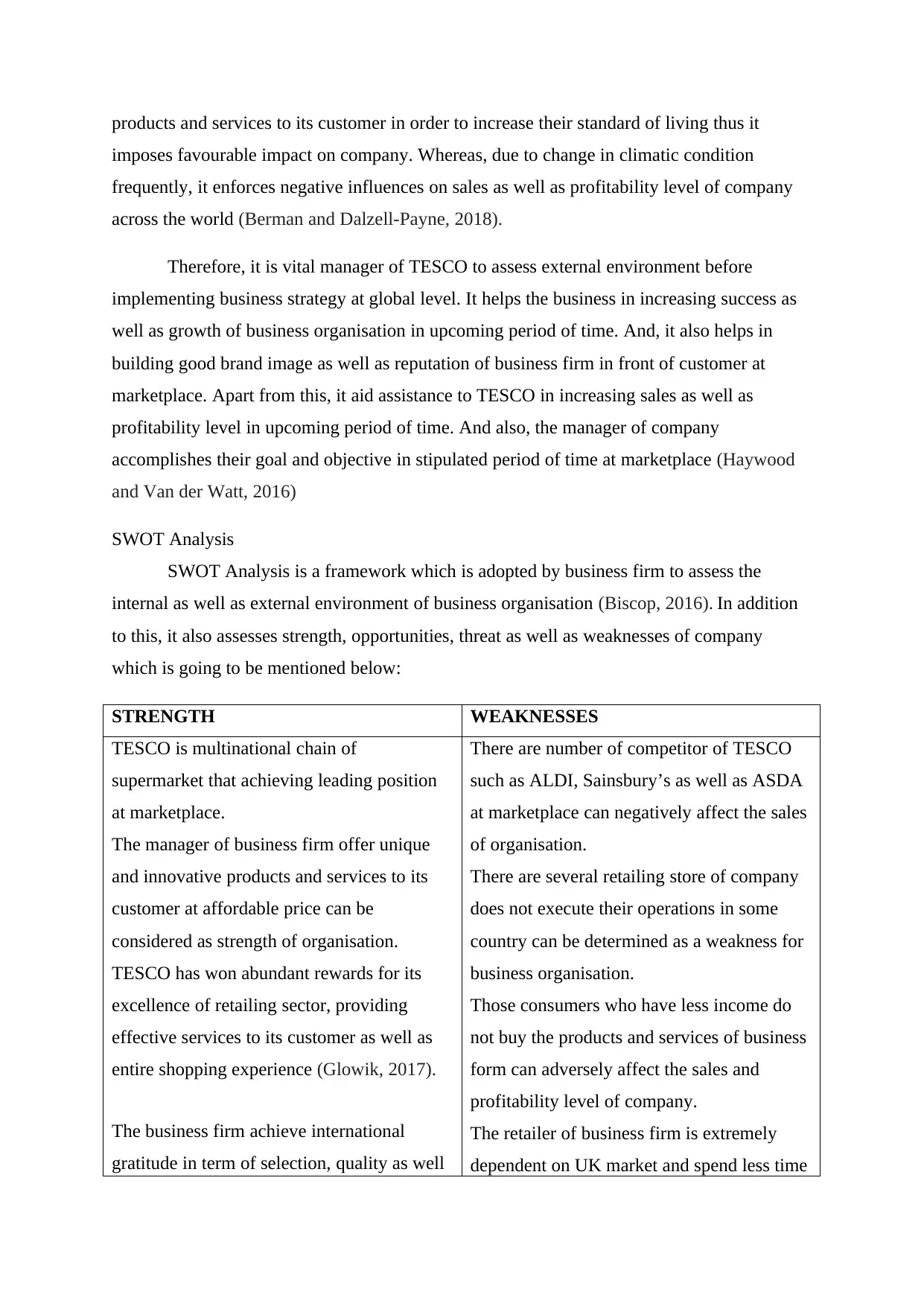
products and services to its customer in order to increase their standard of living thus it
imposes favourable impact on company. Whereas, due to change in climatic condition
frequently, it enforces negative influences on sales as well as profitability level of company
across the world (Berman and Dalzell-Payne, 2018).
Therefore, it is vital manager of TESCO to assess external environment before
implementing business strategy at global level. It helps the business in increasing success as
well as growth of business organisation in upcoming period of time. And, it also helps in
building good brand image as well as reputation of business firm in front of customer at
marketplace. Apart from this, it aid assistance to TESCO in increasing sales as well as
profitability level in upcoming period of time. And also, the manager of company
accomplishes their goal and objective in stipulated period of time at marketplace (Haywood
and Van der Watt, 2016)
SWOT Analysis
SWOT Analysis is a framework which is adopted by business firm to assess the
internal as well as external environment of business organisation (Biscop, 2016). In addition
to this, it also assesses strength, opportunities, threat as well as weaknesses of company
which is going to be mentioned below:
STRENGTH WEAKNESSES
TESCO is multinational chain of
supermarket that achieving leading position
at marketplace.
The manager of business firm offer unique
and innovative products and services to its
customer at affordable price can be
considered as strength of organisation.
TESCO has won abundant rewards for its
excellence of retailing sector, providing
effective services to its customer as well as
entire shopping experience (Glowik, 2017).
The business firm achieve international
gratitude in term of selection, quality as well
There are number of competitor of TESCO
such as ALDI, Sainsbury’s as well as ASDA
at marketplace can negatively affect the sales
of organisation.
There are several retailing store of company
does not execute their operations in some
country can be determined as a weakness for
business organisation.
Those consumers who have less income do
not buy the products and services of business
form can adversely affect the sales and
profitability level of company.
The retailer of business firm is extremely
dependent on UK market and spend less time
imposes favourable impact on company. Whereas, due to change in climatic condition
frequently, it enforces negative influences on sales as well as profitability level of company
across the world (Berman and Dalzell-Payne, 2018).
Therefore, it is vital manager of TESCO to assess external environment before
implementing business strategy at global level. It helps the business in increasing success as
well as growth of business organisation in upcoming period of time. And, it also helps in
building good brand image as well as reputation of business firm in front of customer at
marketplace. Apart from this, it aid assistance to TESCO in increasing sales as well as
profitability level in upcoming period of time. And also, the manager of company
accomplishes their goal and objective in stipulated period of time at marketplace (Haywood
and Van der Watt, 2016)
SWOT Analysis
SWOT Analysis is a framework which is adopted by business firm to assess the
internal as well as external environment of business organisation (Biscop, 2016). In addition
to this, it also assesses strength, opportunities, threat as well as weaknesses of company
which is going to be mentioned below:
STRENGTH WEAKNESSES
TESCO is multinational chain of
supermarket that achieving leading position
at marketplace.
The manager of business firm offer unique
and innovative products and services to its
customer at affordable price can be
considered as strength of organisation.
TESCO has won abundant rewards for its
excellence of retailing sector, providing
effective services to its customer as well as
entire shopping experience (Glowik, 2017).
The business firm achieve international
gratitude in term of selection, quality as well
There are number of competitor of TESCO
such as ALDI, Sainsbury’s as well as ASDA
at marketplace can negatively affect the sales
of organisation.
There are several retailing store of company
does not execute their operations in some
country can be determined as a weakness for
business organisation.
Those consumers who have less income do
not buy the products and services of business
form can adversely affect the sales and
profitability level of company.
The retailer of business firm is extremely
dependent on UK market and spend less time
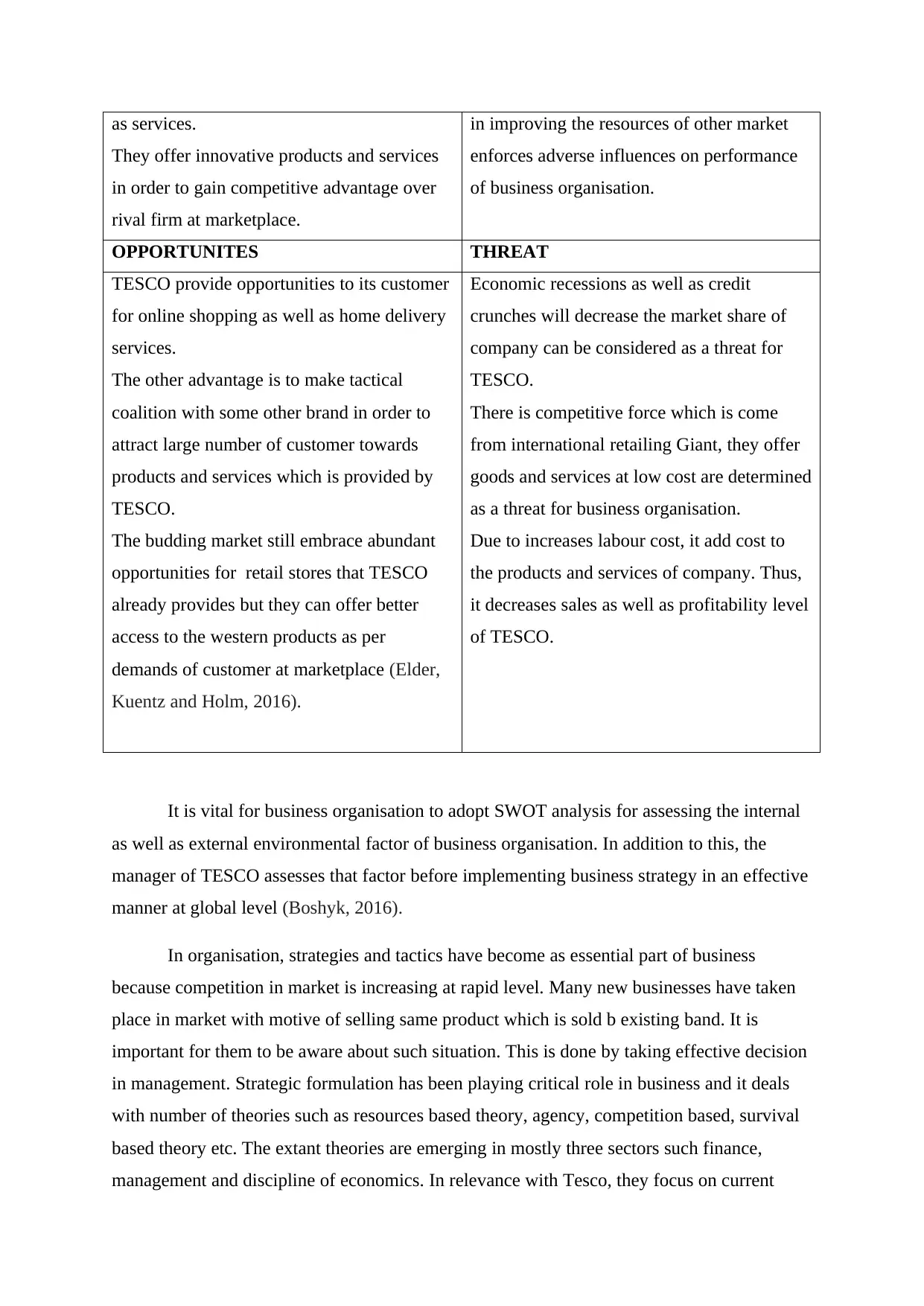
as services.
They offer innovative products and services
in order to gain competitive advantage over
rival firm at marketplace.
in improving the resources of other market
enforces adverse influences on performance
of business organisation.
OPPORTUNITES THREAT
TESCO provide opportunities to its customer
for online shopping as well as home delivery
services.
The other advantage is to make tactical
coalition with some other brand in order to
attract large number of customer towards
products and services which is provided by
TESCO.
The budding market still embrace abundant
opportunities for retail stores that TESCO
already provides but they can offer better
access to the western products as per
demands of customer at marketplace (Elder,
Kuentz and Holm, 2016).
Economic recessions as well as credit
crunches will decrease the market share of
company can be considered as a threat for
TESCO.
There is competitive force which is come
from international retailing Giant, they offer
goods and services at low cost are determined
as a threat for business organisation.
Due to increases labour cost, it add cost to
the products and services of company. Thus,
it decreases sales as well as profitability level
of TESCO.
It is vital for business organisation to adopt SWOT analysis for assessing the internal
as well as external environmental factor of business organisation. In addition to this, the
manager of TESCO assesses that factor before implementing business strategy in an effective
manner at global level (Boshyk, 2016).
In organisation, strategies and tactics have become as essential part of business
because competition in market is increasing at rapid level. Many new businesses have taken
place in market with motive of selling same product which is sold b existing band. It is
important for them to be aware about such situation. This is done by taking effective decision
in management. Strategic formulation has been playing critical role in business and it deals
with number of theories such as resources based theory, agency, competition based, survival
based theory etc. The extant theories are emerging in mostly three sectors such finance,
management and discipline of economics. In relevance with Tesco, they focus on current
They offer innovative products and services
in order to gain competitive advantage over
rival firm at marketplace.
in improving the resources of other market
enforces adverse influences on performance
of business organisation.
OPPORTUNITES THREAT
TESCO provide opportunities to its customer
for online shopping as well as home delivery
services.
The other advantage is to make tactical
coalition with some other brand in order to
attract large number of customer towards
products and services which is provided by
TESCO.
The budding market still embrace abundant
opportunities for retail stores that TESCO
already provides but they can offer better
access to the western products as per
demands of customer at marketplace (Elder,
Kuentz and Holm, 2016).
Economic recessions as well as credit
crunches will decrease the market share of
company can be considered as a threat for
TESCO.
There is competitive force which is come
from international retailing Giant, they offer
goods and services at low cost are determined
as a threat for business organisation.
Due to increases labour cost, it add cost to
the products and services of company. Thus,
it decreases sales as well as profitability level
of TESCO.
It is vital for business organisation to adopt SWOT analysis for assessing the internal
as well as external environmental factor of business organisation. In addition to this, the
manager of TESCO assesses that factor before implementing business strategy in an effective
manner at global level (Boshyk, 2016).
In organisation, strategies and tactics have become as essential part of business
because competition in market is increasing at rapid level. Many new businesses have taken
place in market with motive of selling same product which is sold b existing band. It is
important for them to be aware about such situation. This is done by taking effective decision
in management. Strategic formulation has been playing critical role in business and it deals
with number of theories such as resources based theory, agency, competition based, survival
based theory etc. The extant theories are emerging in mostly three sectors such finance,
management and discipline of economics. In relevance with Tesco, they focus on current
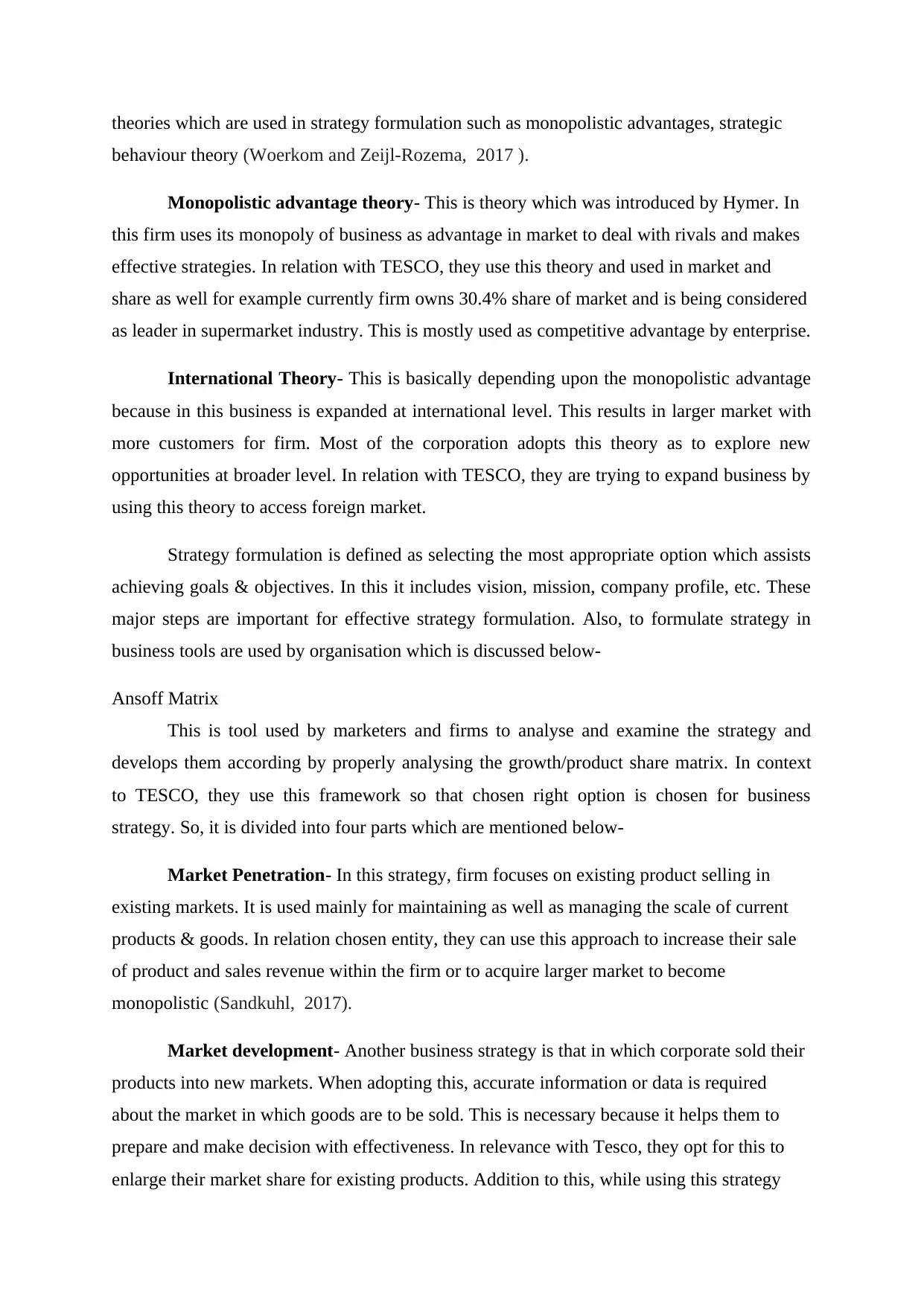
theories which are used in strategy formulation such as monopolistic advantages, strategic
behaviour theory (Woerkom and Zeijl-Rozema, 2017 ).
Monopolistic advantage theory- This is theory which was introduced by Hymer. In
this firm uses its monopoly of business as advantage in market to deal with rivals and makes
effective strategies. In relation with TESCO, they use this theory and used in market and
share as well for example currently firm owns 30.4% share of market and is being considered
as leader in supermarket industry. This is mostly used as competitive advantage by enterprise.
International Theory- This is basically depending upon the monopolistic advantage
because in this business is expanded at international level. This results in larger market with
more customers for firm. Most of the corporation adopts this theory as to explore new
opportunities at broader level. In relation with TESCO, they are trying to expand business by
using this theory to access foreign market.
Strategy formulation is defined as selecting the most appropriate option which assists
achieving goals & objectives. In this it includes vision, mission, company profile, etc. These
major steps are important for effective strategy formulation. Also, to formulate strategy in
business tools are used by organisation which is discussed below-
Ansoff Matrix
This is tool used by marketers and firms to analyse and examine the strategy and
develops them according by properly analysing the growth/product share matrix. In context
to TESCO, they use this framework so that chosen right option is chosen for business
strategy. So, it is divided into four parts which are mentioned below-
Market Penetration- In this strategy, firm focuses on existing product selling in
existing markets. It is used mainly for maintaining as well as managing the scale of current
products & goods. In relation chosen entity, they can use this approach to increase their sale
of product and sales revenue within the firm or to acquire larger market to become
monopolistic (Sandkuhl, 2017).
Market development- Another business strategy is that in which corporate sold their
products into new markets. When adopting this, accurate information or data is required
about the market in which goods are to be sold. This is necessary because it helps them to
prepare and make decision with effectiveness. In relevance with Tesco, they opt for this to
enlarge their market share for existing products. Addition to this, while using this strategy
behaviour theory (Woerkom and Zeijl-Rozema, 2017 ).
Monopolistic advantage theory- This is theory which was introduced by Hymer. In
this firm uses its monopoly of business as advantage in market to deal with rivals and makes
effective strategies. In relation with TESCO, they use this theory and used in market and
share as well for example currently firm owns 30.4% share of market and is being considered
as leader in supermarket industry. This is mostly used as competitive advantage by enterprise.
International Theory- This is basically depending upon the monopolistic advantage
because in this business is expanded at international level. This results in larger market with
more customers for firm. Most of the corporation adopts this theory as to explore new
opportunities at broader level. In relation with TESCO, they are trying to expand business by
using this theory to access foreign market.
Strategy formulation is defined as selecting the most appropriate option which assists
achieving goals & objectives. In this it includes vision, mission, company profile, etc. These
major steps are important for effective strategy formulation. Also, to formulate strategy in
business tools are used by organisation which is discussed below-
Ansoff Matrix
This is tool used by marketers and firms to analyse and examine the strategy and
develops them according by properly analysing the growth/product share matrix. In context
to TESCO, they use this framework so that chosen right option is chosen for business
strategy. So, it is divided into four parts which are mentioned below-
Market Penetration- In this strategy, firm focuses on existing product selling in
existing markets. It is used mainly for maintaining as well as managing the scale of current
products & goods. In relation chosen entity, they can use this approach to increase their sale
of product and sales revenue within the firm or to acquire larger market to become
monopolistic (Sandkuhl, 2017).
Market development- Another business strategy is that in which corporate sold their
products into new markets. When adopting this, accurate information or data is required
about the market in which goods are to be sold. This is necessary because it helps them to
prepare and make decision with effectiveness. In relevance with Tesco, they opt for this to
enlarge their market share for existing products. Addition to this, while using this strategy
Paraphrase This Document
Need a fresh take? Get an instant paraphrase of this document with our AI Paraphraser

they also may have access to international market broadly. In the host country, they move
their store into more convenient place which is easily access by customers.
Product Development- Further comes the product development strategy in which
new product is introduced into existing markets. This is mostly adopted by that enterprise
who wants to attract and acquire new as well as old customers in their business for rapid
development. In context to Tesco, they have expanded their petrol sales & are developing
their financial services across the region.
Diversification- Next one is diversification in which new products are introduced into
new market. It is most risky strategy from the entire above explained one. This is because in
this market situation is not known which makes it difficult for the business to take decision in
proper manner. So, this is mostly used by those corporation who good background of
business or are financially strong. In relation chosen firm, they have risk their capital as
Tesco mobile is their product in new market which might affect their sales revenue at depth.
So, when selecting such strategies proper consideration is to be undertaken so that problems
& errors do not arise.
To make strategy formulation with motive of international development it is crucial to
select the right choice with appropriate decision. Because, while choosing these strategies
decides whether business is going to be run in market or not.
After a brief analysis of above paragraph, it is examined that strategy formulation is
necessary for business to grow and develop at both national as well as international level. So,
to access internationalisation current and extant theory is to focused properly by applying
tools (Roll, 2016).
To response to challenges of internationalisation and formulate business strategy
Tesco have used global business strategic dimension and Porter Generic model. Both these
two concept assist firm in analysing the market situation and trends in appropriate manner.
Through this, it becomes easy to understand the formulation of strategy & challenges of
internationalisation.
Global Business strategy
This includes four quadrants which are divided explained below-
their store into more convenient place which is easily access by customers.
Product Development- Further comes the product development strategy in which
new product is introduced into existing markets. This is mostly adopted by that enterprise
who wants to attract and acquire new as well as old customers in their business for rapid
development. In context to Tesco, they have expanded their petrol sales & are developing
their financial services across the region.
Diversification- Next one is diversification in which new products are introduced into
new market. It is most risky strategy from the entire above explained one. This is because in
this market situation is not known which makes it difficult for the business to take decision in
proper manner. So, this is mostly used by those corporation who good background of
business or are financially strong. In relation chosen firm, they have risk their capital as
Tesco mobile is their product in new market which might affect their sales revenue at depth.
So, when selecting such strategies proper consideration is to be undertaken so that problems
& errors do not arise.
To make strategy formulation with motive of international development it is crucial to
select the right choice with appropriate decision. Because, while choosing these strategies
decides whether business is going to be run in market or not.
After a brief analysis of above paragraph, it is examined that strategy formulation is
necessary for business to grow and develop at both national as well as international level. So,
to access internationalisation current and extant theory is to focused properly by applying
tools (Roll, 2016).
To response to challenges of internationalisation and formulate business strategy
Tesco have used global business strategic dimension and Porter Generic model. Both these
two concept assist firm in analysing the market situation and trends in appropriate manner.
Through this, it becomes easy to understand the formulation of strategy & challenges of
internationalisation.
Global Business strategy
This includes four quadrants which are divided explained below-
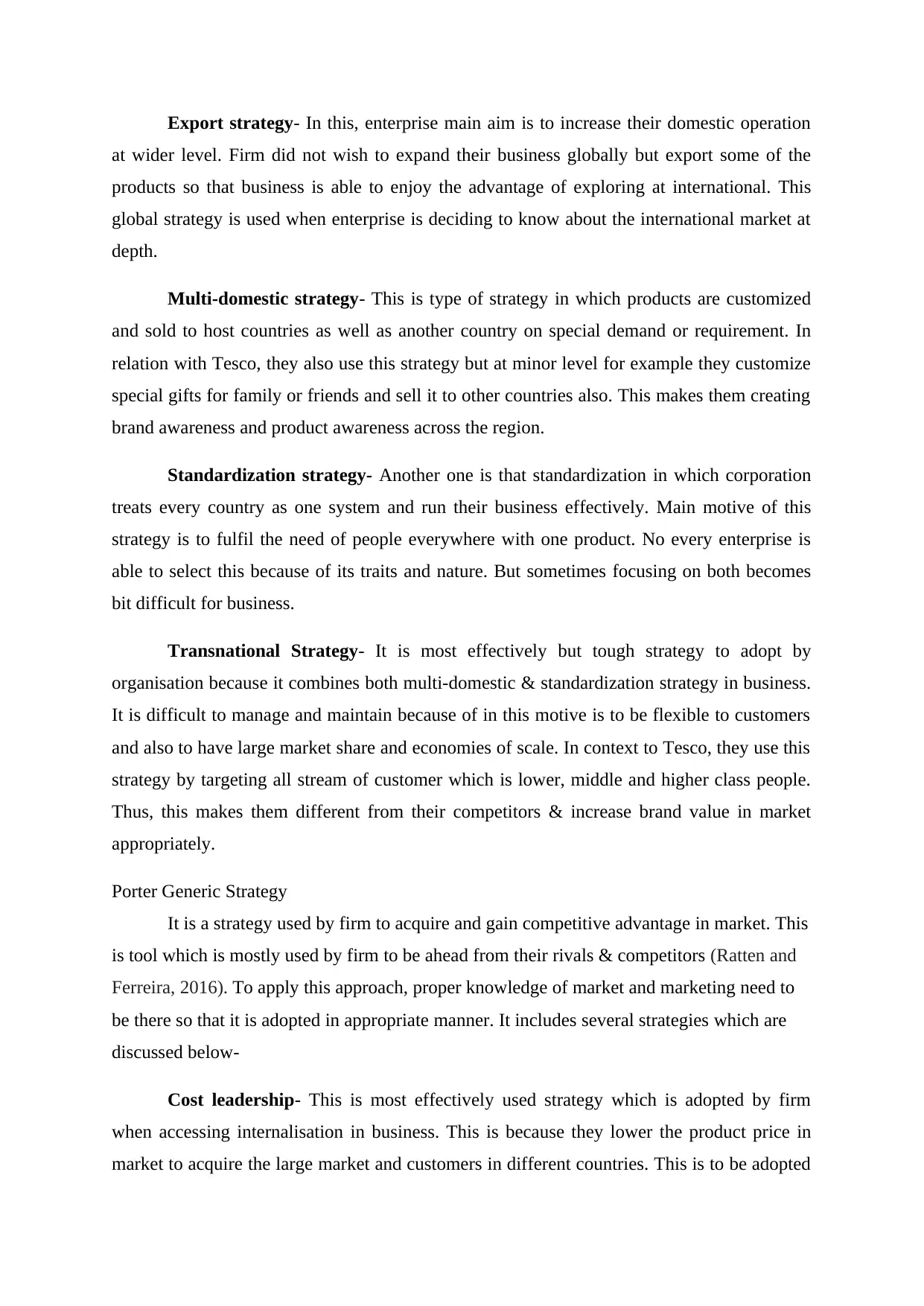
Export strategy- In this, enterprise main aim is to increase their domestic operation
at wider level. Firm did not wish to expand their business globally but export some of the
products so that business is able to enjoy the advantage of exploring at international. This
global strategy is used when enterprise is deciding to know about the international market at
depth.
Multi-domestic strategy- This is type of strategy in which products are customized
and sold to host countries as well as another country on special demand or requirement. In
relation with Tesco, they also use this strategy but at minor level for example they customize
special gifts for family or friends and sell it to other countries also. This makes them creating
brand awareness and product awareness across the region.
Standardization strategy- Another one is that standardization in which corporation
treats every country as one system and run their business effectively. Main motive of this
strategy is to fulfil the need of people everywhere with one product. No every enterprise is
able to select this because of its traits and nature. But sometimes focusing on both becomes
bit difficult for business.
Transnational Strategy- It is most effectively but tough strategy to adopt by
organisation because it combines both multi-domestic & standardization strategy in business.
It is difficult to manage and maintain because of in this motive is to be flexible to customers
and also to have large market share and economies of scale. In context to Tesco, they use this
strategy by targeting all stream of customer which is lower, middle and higher class people.
Thus, this makes them different from their competitors & increase brand value in market
appropriately.
Porter Generic Strategy
It is a strategy used by firm to acquire and gain competitive advantage in market. This
is tool which is mostly used by firm to be ahead from their rivals & competitors (Ratten and
Ferreira, 2016). To apply this approach, proper knowledge of market and marketing need to
be there so that it is adopted in appropriate manner. It includes several strategies which are
discussed below-
Cost leadership- This is most effectively used strategy which is adopted by firm
when accessing internalisation in business. This is because they lower the product price in
market to acquire the large market and customers in different countries. This is to be adopted
at wider level. Firm did not wish to expand their business globally but export some of the
products so that business is able to enjoy the advantage of exploring at international. This
global strategy is used when enterprise is deciding to know about the international market at
depth.
Multi-domestic strategy- This is type of strategy in which products are customized
and sold to host countries as well as another country on special demand or requirement. In
relation with Tesco, they also use this strategy but at minor level for example they customize
special gifts for family or friends and sell it to other countries also. This makes them creating
brand awareness and product awareness across the region.
Standardization strategy- Another one is that standardization in which corporation
treats every country as one system and run their business effectively. Main motive of this
strategy is to fulfil the need of people everywhere with one product. No every enterprise is
able to select this because of its traits and nature. But sometimes focusing on both becomes
bit difficult for business.
Transnational Strategy- It is most effectively but tough strategy to adopt by
organisation because it combines both multi-domestic & standardization strategy in business.
It is difficult to manage and maintain because of in this motive is to be flexible to customers
and also to have large market share and economies of scale. In context to Tesco, they use this
strategy by targeting all stream of customer which is lower, middle and higher class people.
Thus, this makes them different from their competitors & increase brand value in market
appropriately.
Porter Generic Strategy
It is a strategy used by firm to acquire and gain competitive advantage in market. This
is tool which is mostly used by firm to be ahead from their rivals & competitors (Ratten and
Ferreira, 2016). To apply this approach, proper knowledge of market and marketing need to
be there so that it is adopted in appropriate manner. It includes several strategies which are
discussed below-
Cost leadership- This is most effectively used strategy which is adopted by firm
when accessing internalisation in business. This is because they lower the product price in
market to acquire the large market and customers in different countries. This is to be adopted
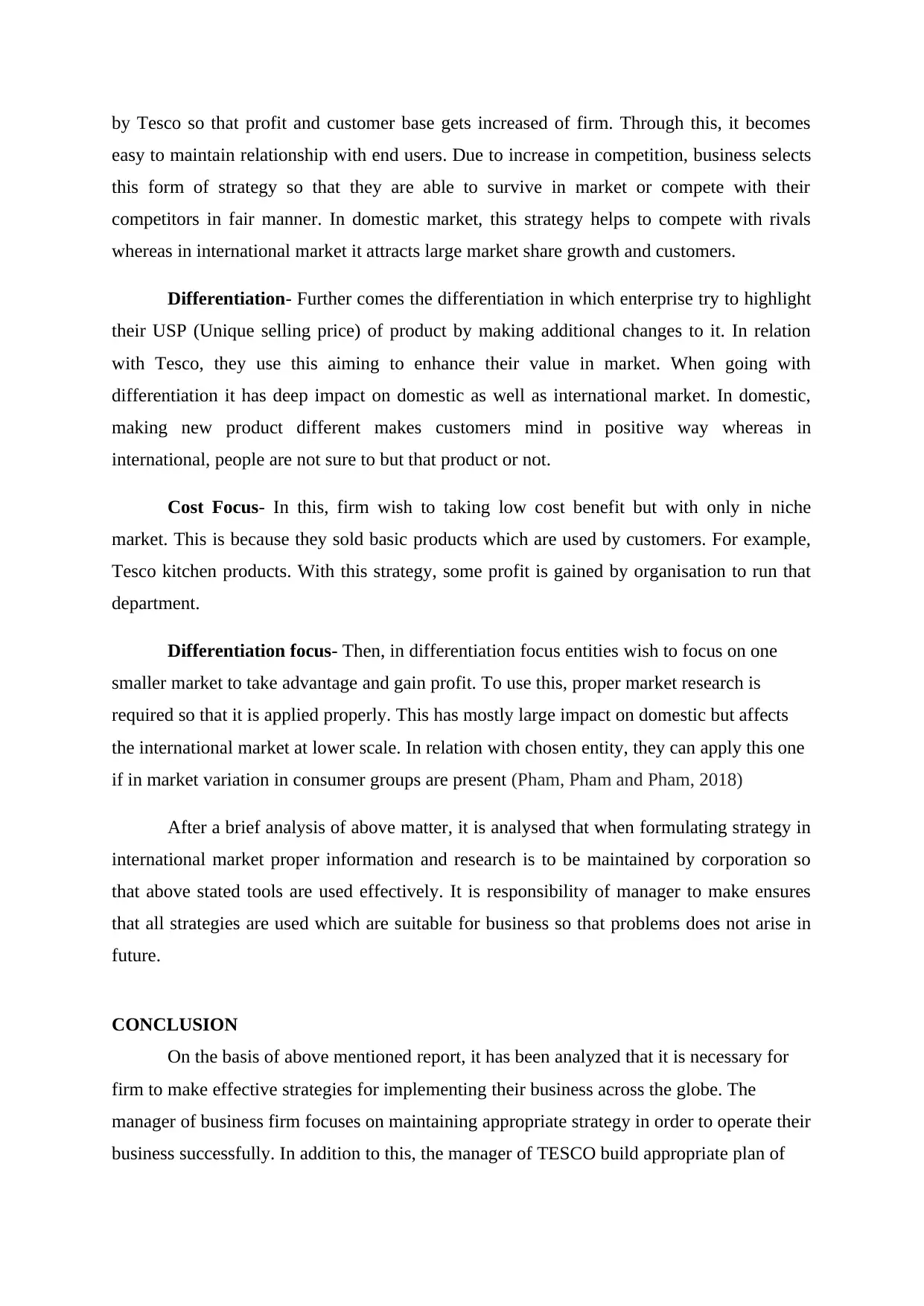
by Tesco so that profit and customer base gets increased of firm. Through this, it becomes
easy to maintain relationship with end users. Due to increase in competition, business selects
this form of strategy so that they are able to survive in market or compete with their
competitors in fair manner. In domestic market, this strategy helps to compete with rivals
whereas in international market it attracts large market share growth and customers.
Differentiation- Further comes the differentiation in which enterprise try to highlight
their USP (Unique selling price) of product by making additional changes to it. In relation
with Tesco, they use this aiming to enhance their value in market. When going with
differentiation it has deep impact on domestic as well as international market. In domestic,
making new product different makes customers mind in positive way whereas in
international, people are not sure to but that product or not.
Cost Focus- In this, firm wish to taking low cost benefit but with only in niche
market. This is because they sold basic products which are used by customers. For example,
Tesco kitchen products. With this strategy, some profit is gained by organisation to run that
department.
Differentiation focus- Then, in differentiation focus entities wish to focus on one
smaller market to take advantage and gain profit. To use this, proper market research is
required so that it is applied properly. This has mostly large impact on domestic but affects
the international market at lower scale. In relation with chosen entity, they can apply this one
if in market variation in consumer groups are present (Pham, Pham and Pham, 2018)
After a brief analysis of above matter, it is analysed that when formulating strategy in
international market proper information and research is to be maintained by corporation so
that above stated tools are used effectively. It is responsibility of manager to make ensures
that all strategies are used which are suitable for business so that problems does not arise in
future.
CONCLUSION
On the basis of above mentioned report, it has been analyzed that it is necessary for
firm to make effective strategies for implementing their business across the globe. The
manager of business firm focuses on maintaining appropriate strategy in order to operate their
business successfully. In addition to this, the manager of TESCO build appropriate plan of
easy to maintain relationship with end users. Due to increase in competition, business selects
this form of strategy so that they are able to survive in market or compete with their
competitors in fair manner. In domestic market, this strategy helps to compete with rivals
whereas in international market it attracts large market share growth and customers.
Differentiation- Further comes the differentiation in which enterprise try to highlight
their USP (Unique selling price) of product by making additional changes to it. In relation
with Tesco, they use this aiming to enhance their value in market. When going with
differentiation it has deep impact on domestic as well as international market. In domestic,
making new product different makes customers mind in positive way whereas in
international, people are not sure to but that product or not.
Cost Focus- In this, firm wish to taking low cost benefit but with only in niche
market. This is because they sold basic products which are used by customers. For example,
Tesco kitchen products. With this strategy, some profit is gained by organisation to run that
department.
Differentiation focus- Then, in differentiation focus entities wish to focus on one
smaller market to take advantage and gain profit. To use this, proper market research is
required so that it is applied properly. This has mostly large impact on domestic but affects
the international market at lower scale. In relation with chosen entity, they can apply this one
if in market variation in consumer groups are present (Pham, Pham and Pham, 2018)
After a brief analysis of above matter, it is analysed that when formulating strategy in
international market proper information and research is to be maintained by corporation so
that above stated tools are used effectively. It is responsibility of manager to make ensures
that all strategies are used which are suitable for business so that problems does not arise in
future.
CONCLUSION
On the basis of above mentioned report, it has been analyzed that it is necessary for
firm to make effective strategies for implementing their business across the globe. The
manager of business firm focuses on maintaining appropriate strategy in order to operate their
business successfully. In addition to this, the manager of TESCO build appropriate plan of
Secure Best Marks with AI Grader
Need help grading? Try our AI Grader for instant feedback on your assignments.
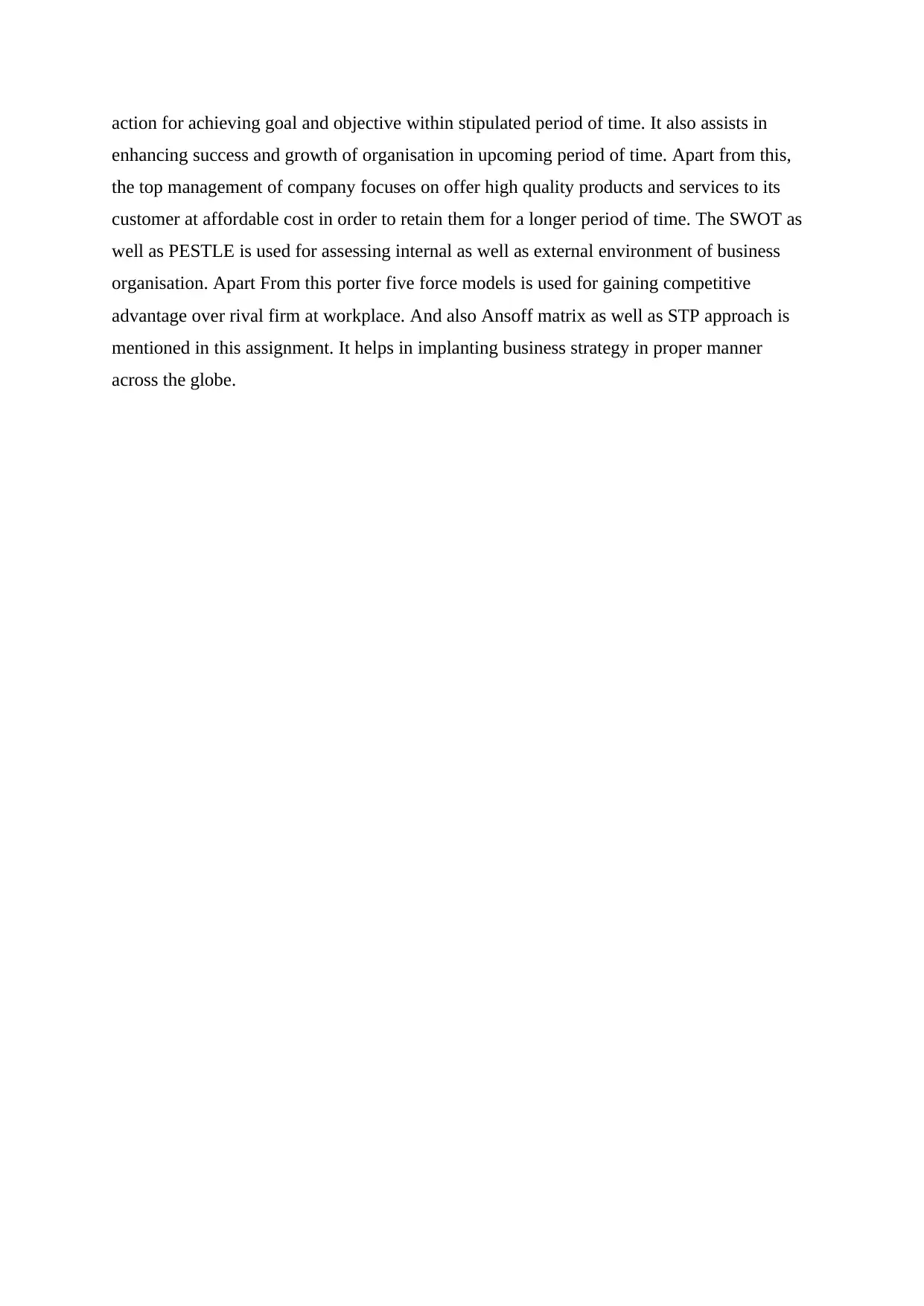
action for achieving goal and objective within stipulated period of time. It also assists in
enhancing success and growth of organisation in upcoming period of time. Apart from this,
the top management of company focuses on offer high quality products and services to its
customer at affordable cost in order to retain them for a longer period of time. The SWOT as
well as PESTLE is used for assessing internal as well as external environment of business
organisation. Apart From this porter five force models is used for gaining competitive
advantage over rival firm at workplace. And also Ansoff matrix as well as STP approach is
mentioned in this assignment. It helps in implanting business strategy in proper manner
across the globe.
enhancing success and growth of organisation in upcoming period of time. Apart from this,
the top management of company focuses on offer high quality products and services to its
customer at affordable cost in order to retain them for a longer period of time. The SWOT as
well as PESTLE is used for assessing internal as well as external environment of business
organisation. Apart From this porter five force models is used for gaining competitive
advantage over rival firm at workplace. And also Ansoff matrix as well as STP approach is
mentioned in this assignment. It helps in implanting business strategy in proper manner
across the globe.

REFERENCES
Books and Journals
Ahmad, J. and Krishnan, M., 2017. Environmental Related CSR Initiatives for Business
Strategy: A Case Study on Small and Medium (SME) Industries in Malaysia. In The
Dynamics of Corporate Social Responsibility (pp. 305-322). Springer, Cham.
András, K. and Havran, Z., 2016. Examination of Central and Eastern European Professional
Football Clubs’ Sport Success, Financial Position and Business Strategy in International
Environment. In Competitiveness of CEE Economies and Businesses (pp. 197-210). Springer,
Cham.
Baumgartner, M.A. and Tippmann, E., 2019. A delicate balance: how multinationals can
harmonize local and global strategies. Journal of Business Strategy.
Bele, N., Panigrahi, P.K. and Srivastava, S.K., 2017. Political sentiment mining: A new age
intelligence tool for business strategy formulation. International Journal of Business
Intelligence Research (IJBIR), 8(1), pp.55-70.
Berman, S. and Dalzell-Payne, P., 2018. The interaction of strategy and technology in an era
of business re-invention. Strategy & Leadership.
Biscop, S., 2016. The European security strategy: a global agenda for positive power.
Routledge.
Boshyk, Y. ed., 2016. Business driven action learning: Global best practices. Springer.
Elder, D.P., Kuentz, M. and Holm, R., 2016. Antibiotic resistance: the need for a global
strategy. Journal of pharmaceutical sciences, 105(8), pp.2278-2287.
Glowik, M., 2017. Global Strategy in the Service Industries: Dynamics, Analysis, Growth.
Taylor & Francis.
Haywood, L.K. and Van der Watt, C., 2016. Building resilience into business strategy,
management and reporting: Principles and maturity tool to facilitate resilience in business,
2016.
Japutra, A., Nguyen, B. and Melewar, T.C., 2019. A Framework of Brand Strategy and the
“Glocalization” Approach: The Case of Indonesia. In Brand Culture and Identity: Concepts,
Methodologies, Tools, and Applications (pp. 340-364). IGI global.
Johnson, G., 2016. Exploring strategy: text and cases. Pearson Education.
Luo, Y. and Bu, J., 2018. Contextualizing international strategy by emerging market firms: A
composition-based approach. Journal of World Business, 53(3), pp.337-355.
Maniora, J., 2018. Mismanagement of sustainability: What business strategy makes the
difference? Empirical evidence from the USA. Journal of Business Ethics, 152(4), pp.931-
947.
Panibratov, A., 2017. International strategy of emerging market firms: Absorbing global
knowledge and building competitive advantage. Taylor & Francis.
Books and Journals
Ahmad, J. and Krishnan, M., 2017. Environmental Related CSR Initiatives for Business
Strategy: A Case Study on Small and Medium (SME) Industries in Malaysia. In The
Dynamics of Corporate Social Responsibility (pp. 305-322). Springer, Cham.
András, K. and Havran, Z., 2016. Examination of Central and Eastern European Professional
Football Clubs’ Sport Success, Financial Position and Business Strategy in International
Environment. In Competitiveness of CEE Economies and Businesses (pp. 197-210). Springer,
Cham.
Baumgartner, M.A. and Tippmann, E., 2019. A delicate balance: how multinationals can
harmonize local and global strategies. Journal of Business Strategy.
Bele, N., Panigrahi, P.K. and Srivastava, S.K., 2017. Political sentiment mining: A new age
intelligence tool for business strategy formulation. International Journal of Business
Intelligence Research (IJBIR), 8(1), pp.55-70.
Berman, S. and Dalzell-Payne, P., 2018. The interaction of strategy and technology in an era
of business re-invention. Strategy & Leadership.
Biscop, S., 2016. The European security strategy: a global agenda for positive power.
Routledge.
Boshyk, Y. ed., 2016. Business driven action learning: Global best practices. Springer.
Elder, D.P., Kuentz, M. and Holm, R., 2016. Antibiotic resistance: the need for a global
strategy. Journal of pharmaceutical sciences, 105(8), pp.2278-2287.
Glowik, M., 2017. Global Strategy in the Service Industries: Dynamics, Analysis, Growth.
Taylor & Francis.
Haywood, L.K. and Van der Watt, C., 2016. Building resilience into business strategy,
management and reporting: Principles and maturity tool to facilitate resilience in business,
2016.
Japutra, A., Nguyen, B. and Melewar, T.C., 2019. A Framework of Brand Strategy and the
“Glocalization” Approach: The Case of Indonesia. In Brand Culture and Identity: Concepts,
Methodologies, Tools, and Applications (pp. 340-364). IGI global.
Johnson, G., 2016. Exploring strategy: text and cases. Pearson Education.
Luo, Y. and Bu, J., 2018. Contextualizing international strategy by emerging market firms: A
composition-based approach. Journal of World Business, 53(3), pp.337-355.
Maniora, J., 2018. Mismanagement of sustainability: What business strategy makes the
difference? Empirical evidence from the USA. Journal of Business Ethics, 152(4), pp.931-
947.
Panibratov, A., 2017. International strategy of emerging market firms: Absorbing global
knowledge and building competitive advantage. Taylor & Francis.
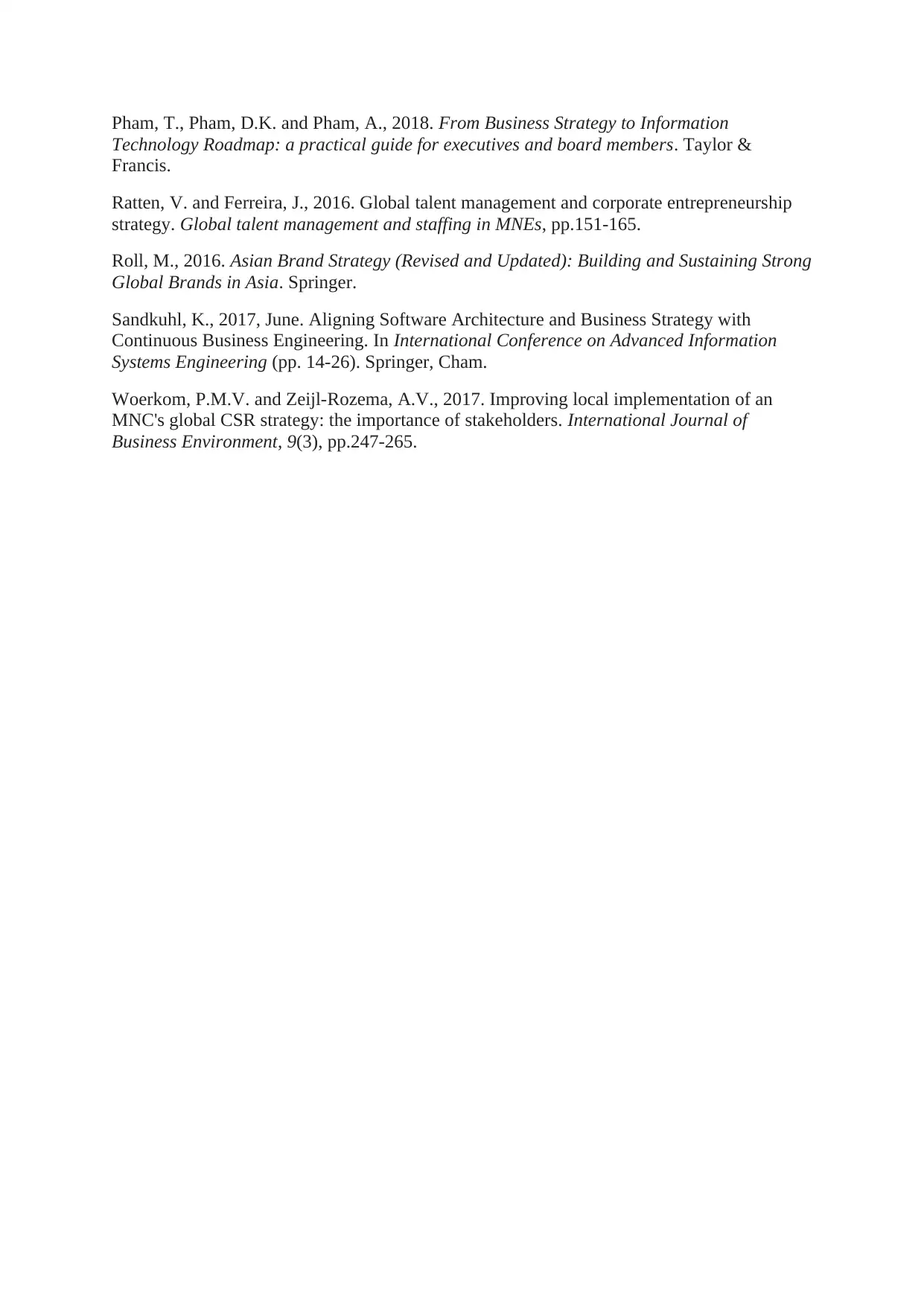
Pham, T., Pham, D.K. and Pham, A., 2018. From Business Strategy to Information
Technology Roadmap: a practical guide for executives and board members. Taylor &
Francis.
Ratten, V. and Ferreira, J., 2016. Global talent management and corporate entrepreneurship
strategy. Global talent management and staffing in MNEs, pp.151-165.
Roll, M., 2016. Asian Brand Strategy (Revised and Updated): Building and Sustaining Strong
Global Brands in Asia. Springer.
Sandkuhl, K., 2017, June. Aligning Software Architecture and Business Strategy with
Continuous Business Engineering. In International Conference on Advanced Information
Systems Engineering (pp. 14-26). Springer, Cham.
Woerkom, P.M.V. and Zeijl-Rozema, A.V., 2017. Improving local implementation of an
MNC's global CSR strategy: the importance of stakeholders. International Journal of
Business Environment, 9(3), pp.247-265.
Technology Roadmap: a practical guide for executives and board members. Taylor &
Francis.
Ratten, V. and Ferreira, J., 2016. Global talent management and corporate entrepreneurship
strategy. Global talent management and staffing in MNEs, pp.151-165.
Roll, M., 2016. Asian Brand Strategy (Revised and Updated): Building and Sustaining Strong
Global Brands in Asia. Springer.
Sandkuhl, K., 2017, June. Aligning Software Architecture and Business Strategy with
Continuous Business Engineering. In International Conference on Advanced Information
Systems Engineering (pp. 14-26). Springer, Cham.
Woerkom, P.M.V. and Zeijl-Rozema, A.V., 2017. Improving local implementation of an
MNC's global CSR strategy: the importance of stakeholders. International Journal of
Business Environment, 9(3), pp.247-265.
1 out of 13
Related Documents
Your All-in-One AI-Powered Toolkit for Academic Success.
+13062052269
info@desklib.com
Available 24*7 on WhatsApp / Email
![[object Object]](/_next/static/media/star-bottom.7253800d.svg)
Unlock your academic potential
© 2024 | Zucol Services PVT LTD | All rights reserved.



